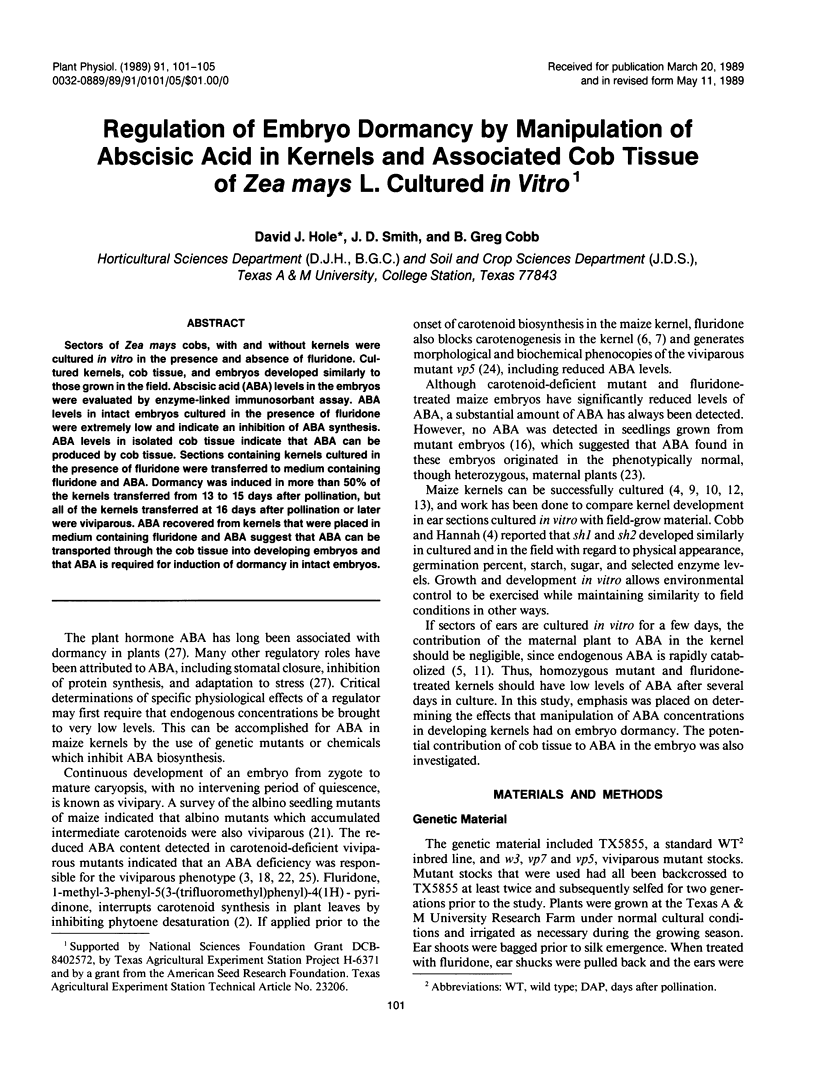Regulation of Embryo Dormancy by Manipulation of Abscisic Acid in Kernels and Associated Cob Tissue of Zea mays L. Cultured in Vitro (original) (raw)
Abstract
Sectors of Zea mays cobs, with and without kernels were cultured in vitro in the presence and absence of fluridone. Cultured kernels, cob tissue, and embryos developed similarly to those grown in the field. Abscisic acid (ABA) levels in the embryos were evaluated by enzyme-linked immunosorbant assay. ABA levels in intact embryos cultured in the presence of fluridone were extremely low and indicate an inhibition of ABA synthesis. ABA levels in isolated cob tissue indicate that ABA can be produced by cob tissue. Sections containing kernels cultured in the presence of fluridone were transferred to medium containing fluridone and ABA. Dormancy was induced in more than 50% of the kernels transferred from 13 to 15 days after pollination, but all of the kernels transferred at 16 days after pollination or later were viviparous. ABA recovered from kernels that were placed in medium containing fluridone and ABA suggest that ABA can be transported through the cob tissue into developing embryos and that ABA is required for induction of dormancy in intact embryos.

Selected References
These references are in PubMed. This may not be the complete list of references from this article.
- Creelman R. A., Gage D. A., Stults J. T., Zeevaart J. A. Abscisic Acid Biosynthesis in Leaves and Roots of Xanthium strumarium. Plant Physiol. 1987 Nov;85(3):726–732. doi: 10.1104/pp.85.3.726. [DOI] [PMC free article] [PubMed] [Google Scholar]
- Fong F., Smith J. D., Koehler D. E. Early Events in Maize Seed Development : 1-Methyl-3-phenyl-5-(3-[trifluoromethyl]phenyl)-4-(1H)-Pyridinone Induction of Vivipary. Plant Physiol. 1983 Dec;73(4):899–901. doi: 10.1104/pp.73.4.899. [DOI] [PMC free article] [PubMed] [Google Scholar]
- Hanft J. M., Jones R. J. Kernel abortion in maize : I. Carbohydrate concentration patterns and Acid invertase activity of maize kernels induced to abort in vitro. Plant Physiol. 1986 Jun;81(2):503–510. doi: 10.1104/pp.81.2.503. [DOI] [PMC free article] [PubMed] [Google Scholar]
- Harrison M. A., Walton D. C. Abscisic Acid Metabolism in Water-stressed Bean Leaves. Plant Physiol. 1975 Aug;56(2):250–254. doi: 10.1104/pp.56.2.250. [DOI] [PMC free article] [PubMed] [Google Scholar]
- Jones R. J., Brenner M. L. Distribution of Abscisic Acid in Maize Kernel during Grain Filling. Plant Physiol. 1987 Apr;83(4):905–909. doi: 10.1104/pp.83.4.905. [DOI] [PMC free article] [PubMed] [Google Scholar]
- Munns R., King R. W. Abscisic Acid is not the only stomatal inhibitor in the transpiration stream of wheat plants. Plant Physiol. 1988 Nov;88(3):703–708. doi: 10.1104/pp.88.3.703. [DOI] [PMC free article] [PubMed] [Google Scholar]
- Walker-Simmons M. ABA Levels and Sensitivity in Developing Wheat Embryos of Sprouting Resistant and Susceptible Cultivars. Plant Physiol. 1987 May;84(1):61–66. doi: 10.1104/pp.84.1.61. [DOI] [PMC free article] [PubMed] [Google Scholar]